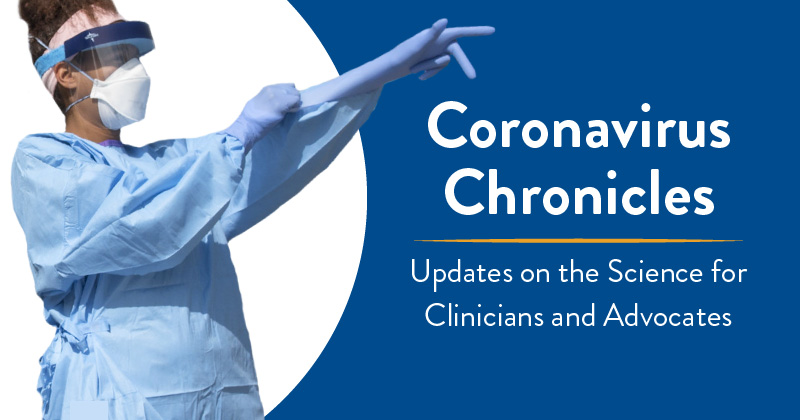Coronavirus Chronicles: Updates on the Science for Clinicians and Advocates

The data on COVID-19 continue to amass, and our understanding of the disease and its impact on vulnerable populations like migrants has grown significantly since March. The news and updates have proliferated at a bewildering rate, leaving many clinicians, including frontline workers like doctors, nurses, and outreach workers, without a clear sense of the key take-home messages from new research. Here, we provide summaries of selected key findings that may be relevant for migrant clinicians and health justice advocates.
COVID-19 is airborne. It is now widely agreed upon that infections primarily spread from particles that have been aerosolized. This means the safest interactions for clinicians and other service providers are outside (where ventilation is best and sunlight can kill the virus) and from a distance, while wearing a mask.
Learn more:
239 Experts With One Big Claim: The Coronavirus Is Airborne, from the New York Times
Is COVID-19 Airborne? A Q&A with Chad Roy, PhD and Ed Zuroweste, MD, MCN’s archived webinar
![]()
Antibodies to the disease might not protect people for long from a reinfection. When a person is infected with a disease, their body produces antibodies to fend off the disease. There is currently no evidence that the presence of antibodies after a COVID-19 infection leads to immunity to future infections, but as antibodies play a role in many diseases as a protector against future disease, there has been hope that such a scenario would play out with COVID-19 as well. New research, however, is showing that people who recovered from COVID-19 seem to lose their antibodies after several months, indicating that they may not get long-term protection from the disease. Nevertheless, people who recently recovered from COVID-19 usually do have enough immediate antibodies to become blood donors to others who are currently suffering from COVID-19 and give them convalescent plasma which has been shown to help in a faster recovery.
Learn more:
Rapid Decay of Anti–SARS-CoV-2 Antibodies in Persons with Mild Covid-19, a letter in the New England Journal of Medicine
“Immunity Passports” in the Context of COVID-19 from the World Health Organization
![]()
The list of COVID-19 symptoms is long and varied. The core symptoms that the CDC calls out are: fever, cough, shortness of breath, fatigue, muscle or body aches, headache, loss of taste or smell, sore throat, congestion or runny nose, nausea, and diarrhea. “This list does not include all possible symptoms,” the CDC notes. New research points to ACE2 receptors as the responsible party for why people infected with COVID-19 may temporarily lose their sense of smell or get the dreaded “COVID toe.”
Learn more:
CDC’s list of symptoms
It’s Not Just the Lungs: The COVID-19 Virus Attacks Like No Other ‘Respiratory’ Infection from STAT News
![]()
COVID-19 can cause blood clots. There is an increased risk of coagulation (abnormal blood clotting) disorders leading to such conditions as deep vein thrombosis (or DVT, the clotting of the deep veins in the legs), pulmonary embolism, stroke, and myocardial infarction that some have experienced during recovery from COVID-19.
Learn more:
COVID CV Sequelae, Thrombosis; FDA OK's Next-Gen LAA Device; Claims Data vs Real Trials from MedPage Today
Autopsies Turn Up Strange Feature of COVID-19 Lungs from MedPage Today
COVID-19: Doctors Round Up Evidence of Damage Outside the Lungs from Medical News Today
![]()
Research on pregnant women and newborn infants has brought new insights. A recent study found that pregnant women with COVID-19 had a “50 percent higher chance of being admitted to intensive care and a 70 percent higher chance of being intubated than nonpregnant women in their childbearing years.” Additionally, and contrary to earlier thought, COVID-19 can be transmitted to infants in utero. Finally, another study found that women in the UK with COVID-19 had a higher rate of stillbirth.
Learn more:
Agonizing Lag in Coronavirus Research Puts Pregnant Women and Babies at Risk from ProPublica
Report: COVID-19 Transmitted to Babies in Utero from MedPage Today
Change in the Incidence of Stillbirth and Preterm Delivery During the COVID-19 Pandemic from JAMA
![]()
Low-wage work in California was associated with the spread of COVID-19 in a new policy brief, providing a new analysis to the troubling concerns MCN partners have been seeing on the ground.
Learn more:
Hidden Threat: California COVID-19 Surges and Worker Distress, Policy Brief from the Community and Labor Center at the University of California, Merced
![]()
COVID-19 has caused disruption of care: Another finding that reflects the realities on the ground, with heavy implications for the migrant and immigrant populations that already encounter numerous barriers to care.
Learn more:
Potential Impact of the COVID-19 Pandemic on HIV, Tuberculosis, and Malaria in Low-Income and Middle-Income Countries: A Modelling Study, from the Lancet
A Crisis of Accountability for Women’s, Children’s, and Adolescents’ Health, a commentary from the Lancet
![]()
Things to watch: These are areas of research that may be important to follow in the coming months.
Infected but not infectious? After recovering from COVID-19, some patients still test positive, which may indicate that dead virus persists in the nasal passages, or perhaps live virus is still circulating, but it is unclear whether a positive test after the patient recovers from symptoms indicates that the patient is actively shedding the virus. The CDC’s newly released recommendation for health care personnel returning to work after a mild COVID-19 infection may reflect the lack of clarity; the CDC does not require a negative test to return to work.
T-Cells: New insight on the role of T-cells “may well prove to be crucial in our fight against COVID-19."
At-home testing may be on the way.
Like what you see? Amplify our collective voice with a contribution.
Got some good news to share? Contact us on our social media pages above.
Return to the main blog page or sign up for blog updates here.
- Log in to post comments